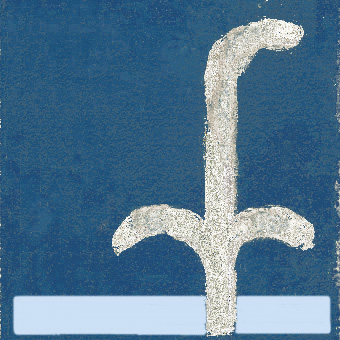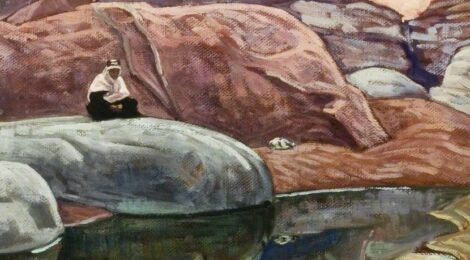
Water – 4
Author: Susan Biddle.
This post is the last of four looking at water, and focuses on the various wells and springs Myrtle Broome encountered on her travels.
Myrtle Broome told her parents about a number of wells and springs which she encountered on her various travels during her eight seasons working in Egypt.
In February 1930, accompanied by their head servant Sardic, a Bedouin guide, and seven other men, Myrtle and Amice Calverley together with a Miss Alexander, one of Amice’s friends, trekked on camels through the Western Desert to the Kharga Oasis. This was Amice and Myrtle’s first desert trek, and not an easy one. Their guide told them they were the first Europeans to take this camel trail for twenty-five years; he had never heard of “solitary” women attempting it as they did.
They took drinking water with them, in petrol tins for themselves and two new goatskin waterskins for the men, but there was no water to spare. Myrtle told her mother that they “trekked 130 miles across waterless desert in 4 days. Average speed with pack camels 2 ¾ to 3 miles per hour. Just think what that meant. We had to push on no matter how tired & stiff we were because everything depended on our water supply lasting out”. She described the “endless plains of stony desert & sandy desert with the wicked mirage shimmering on the horizon”, which they crossed going west “until we came to a place where we stood on the roof of the world & looked down on a country of sand dunes, tossed up rocks, dotted here & there with specks of green where the springs bubbled up & ringed round with a chain of limestone mountains. I never imagined such wild fantastic beauty”. On the fourth day, fifteen to twenty miles before they reached the Kharga Oasis, they came to “a ruined Coptic monastery & a WELL. It was nearly 2 o’clock, & we had been going with only ¼ hour’s break since 6.30. What a joy it was to flop down in the shade of the great wall & see our poor thirsty camels led off to be watered, & how glad we were to drink our own water & feel we need not treasure every drop”.
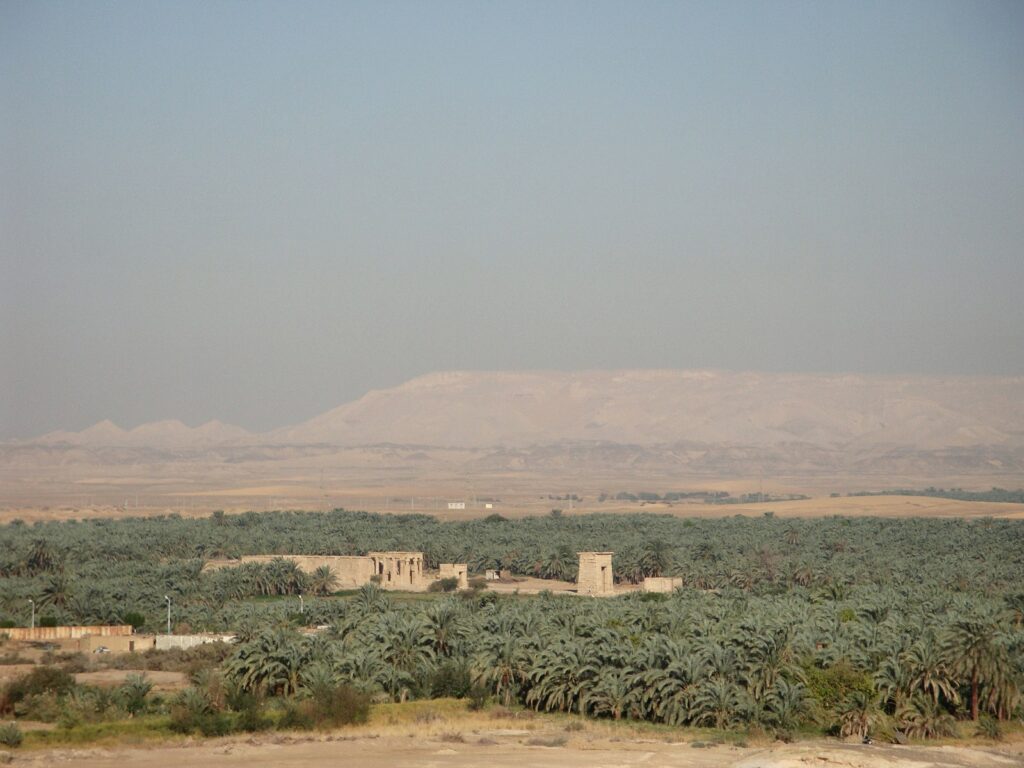
© Kairoinfo4u (Hanne Siegmeier), CC BY 2.0 via Wikimedia Commons
When they arrived in Kharga, they visited the governor of Kharga. He received them most politely, regaled them with coffee, was anxious they should visit the ancient part of Kharga, and “kindly gave one of the guards instructions to show us everything of interest”. After taking them through “lots of quaint old streets & along curious dark tunnels that twisted & turned”, they reached the outskirts of the old village where their guide showed them “one of the springs, it was a large pool with the water bubbling up in the centre. They call it the Eye of the Sheikh”.
In March 1935 Myrtle, this time accompanied only by Sardic, returned to the Kharga and Dakhla Oases, where she visited a number of different villages. On this occasion they were travelling by train and car or lorry. Descriptions of springs often feature in her accounts of these oasis villages. At Gedida (el-Jadida), they were welcomed by the old omdah [headman of the village] who showed her his gardens filled with “oranges, lemons, sweet lemons, apricots, vines, guavas, pomegranates, apples, plums, mulberries, mangoes … and of course date palms”. The gardens were “watered from a spring which bubbles up from the ground & is carried to all parts of the grounds by channels”.

Imagery © 2023 Landsat / Copernicus, Image © 2023 TerraMetrics, Map data © 2023
The next day, after visiting Kasr (el-Qasr), then the last village in the oasis, they drove “another 5 miles & there was a wonderful hot spring bubbling up from the rock. It was so hot that one could only just bear one’s hand in it. Sardic had never seen such a thing before & was very thrilled. This spring waters a marvellously fertile patch of land right at the foot of the mountains”. This was probably Bir el-Gebel, north of el-Qasr, where the water can reach 50º C or more.
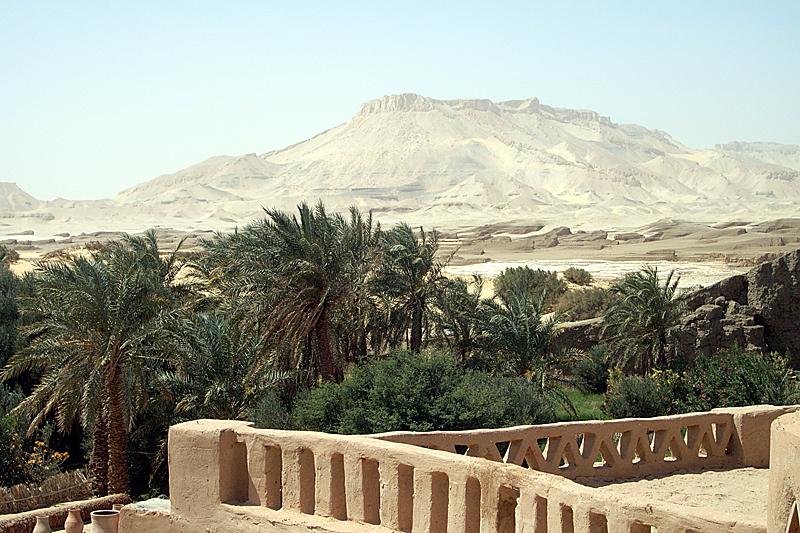
© Roland Unger, CC BY-SA 3.0, via Wikimedia Commons
The following day she went to el-Rashda, another small village, where she went “through marvellous gardens with thousands of date palms. Here was another bubbling spring but cold this time”. On her return to the larger village of Mut, she “visited another spring called the Mad Well because of the way the water bubbles up”; here, she told her mother, “I took off my shoes & stockings & washed my feet. It was lovely soft water, slightly warm”. This was perhaps the spring now known as the “Magic Spring”, so-called because of the way bubbles continually break the surface of the pool.
Later on that same trip she visited Beris and then Bulaq, two more villages about 100 miles south of Kharga. At Beris she “saw a very large spring that supplied all the water for the people & the fields”. On her way to Bulaq she “saw another spring right out in the desert. Sardic was very distressed when he saw all that good water running to waste. It was amazing to see it bubbling out of a great cleft in a rock”.

© Myrtle Broome (date unknown)
Bushey Museum & Art Gallery
At the end of that season, in May 1935, Myrtle spent three weeks in Jerusalem working for British archaeologist James Starkey, who had been excavating at Tell ed-Duweir, Biblical Lachish, with Olga Tufnell with whom Myrtle had worked at Qau el-Kebir in her first season in Egypt in 1927. After “working full steam ahead for a week” Myrtle took an afternoon off to visit “a lovely little village called Ein Karem, five miles out of Jerusalem”. She told her mother that this was “the place where Mary came in haste to the hill country to meet Elizabeth and there she sang the Magnificat. The scenery is lovely, all terraced hills with cypress trees & olive trees”. They “went into a church there, part of which was built by the crusaders”, though the rest was modern; this was presumably the Church of the Visitation, which is close to the well and to remains of the 12th century monastic establishment of which the church was part. Myrtle “saw the women fetching water from the well” and explained to her mother that “‘Ein Karem’ means ‘Generous Water or Well’”. The church Myrtle saw was the one rebuilt in the middle of the 19th century; in 1938 the site was excavated by the Italian archaeologist Bellarmino Bagatti, before the church was rebuilt once again. The lower part of the church is a crypt giving access to a spring and the place where Elizabeth is said to have hidden St John the Baptist from Herod as described in the 3rd century Protoevangelium (or Infancy Gospel) of St James, with the main church on an upper level, and a cistern fed from the spring in the courtyard.
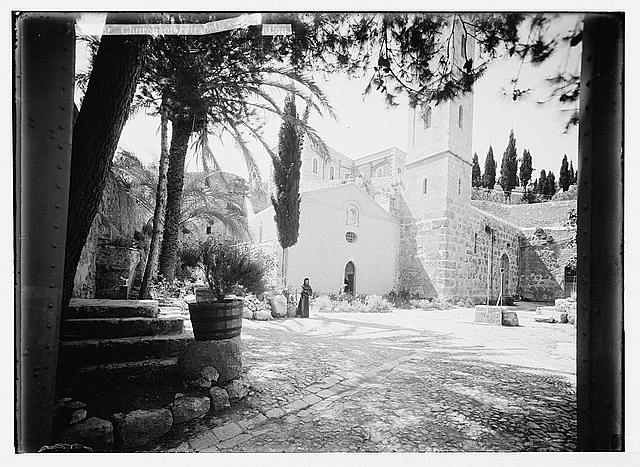
Image in the public domain in the United States
It was on their final trip across the Eastern Desert in 1937 that Myrtle and Amice were shown a particularly beautiful natural well. After following a wadi leading into the heart of the pink granite Quattar mountains for about five miles, they came to the head of the valley where they found “a sort of natural amphitheatre; here was an encampment of Bedouins. They had a well, & there was a little earth so they were able to get enough food for themselves & their camels”. After supper, the Bedouins invited Amice and Myrtle to drink tea around their campfire and “the chief told us he was quite content to pass all his days there, his father had died there & his grandfather before him, & as long as there was sweet water & enough earth to grow food he would be satisfied & not wish to visit the outside world. We told him that he would have to go a very long way before he found a more lovely spot”.
The chief indicated to them that “there was a very beautiful well up in the mountains an hour’s journey on foot & offered to guide us there in the morning”. Amice and Myrtle were of course “delighted at the prospect” and “next morning we started off at the first streak of daylight … We went through the most magnificent scenery, the pass led up & up, part of the time we were clambering over huge boulders or walking along rocky ledges. We found strange little plants growing here & there. Our old guide knew their names & their uses, there was a herb that had a strong pungent odour. We asked if it was used for medicine & he said no, only for scent & went on to explain further thus, ‘If a little child should make a mess – the people crush the herb in their fingers so that there is only a pleasant smell’. We were very amused with his explanation”.
When they reached the end of the pass they “saw a truly marvellous sight, a clear pool stood at the foot of the rocky wall & the water dripped into it from above & the whole of the rock was a cascade of maidenhair fern. To see such a thing in the midst of the stony desert was miraculous & we at once decided that this was the place where Moses struck the rock & the water flowed forth. Little birds came & drank from the water & dragonflies darted to & fro”. They stayed there about an hour but found the pool “icy cold” when they removed their shoes and stockings and dipped their feet in the water.
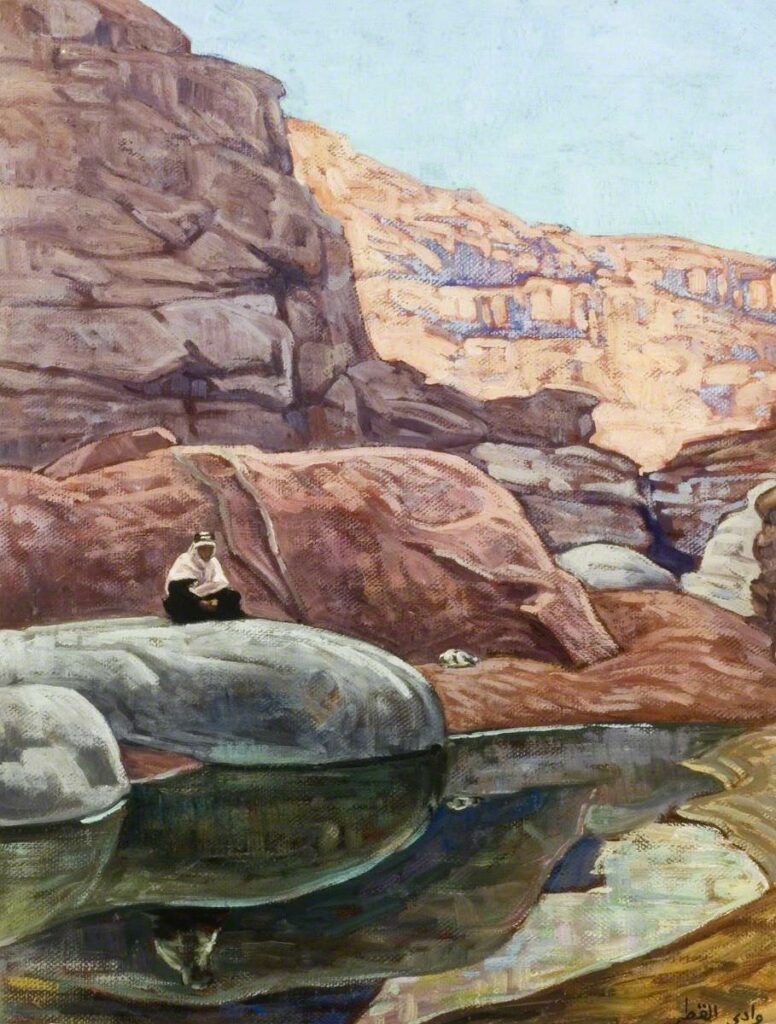
© Myrtle Broome (date unknown)
Bushey Museum & Art Gallery
Sources:
Letters: 62, 63, 64, 65, 329, 330, 342, 403.
With thanks to:
- the Griffith Institute, University of Oxford, for the opportunity to work on the Broome collection, and for their ongoing support for this blog
- the Bushey Museum and Art Gallery, for Myrtle Broome’s paintings
- UNESCO World Heritage Convention website (tentative lists), for information about the Kharga Oasis
- Google Maps, for the aerial view of the Dakhla oasis villages
- the Palestine Exploration Fund, for information about James Starkey and Olga Tufnell
- the Penn Museum, for information about the excavations at Tell ed-Duweir
- the Artefacts of Excavation project, for information about Qau el-Kebir
- Egypt Travel Link, for information about the spring at Bir el-Gebel
- Egyptopia, for information about the “magic spring” at Mut
- Pringle, D., The Churches of the Crusader Kingdoms of Jerusalem: A Corpus. Volume I: A–K (excluding Acre and Jerusalem), Cambridge (1993); Conder, C. R. and Kitchener, H. H., The Survey of Western Palestine: Memoirs of the Topography, Orography, Hydrography, and Archaeology, London (1883), for information about Ein Karem
